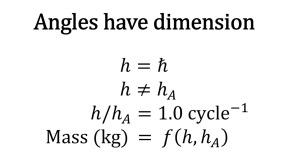普朗克作用常数与Kibble平衡
IF 1.4
4区 物理与天体物理
Q4 PHYSICS, ATOMIC, MOLECULAR & CHEMICAL
引用次数: 0
摘要
这在以前已经被证明(P. R. Bunker和Per Jensen, J. Quant. Spectrosc)。Radiat。Transf., 243(2020) 106835),如果我们选择角度有维度,我们必须区分普朗克常数h,具有作用角- 1的维度,和普朗克常数hA,具有作用的维度。在这篇论文中,我们证明了选择具有维度的角度所产生的一个进一步的含义是,将质量称重到普朗克常数的基布尔平衡方程必须包含两个不同的基本常数h和hA。我们在这里推导了这个新方程,并展示了它与在SI中选择无量纲角度时得到的方程的比较。本文章由计算机程序翻译,如有差异,请以英文原文为准。

The Planck constant of action and the Kibble balance
It has been shown previously (P. R. Bunker and Per Jensen, J. Quant. Spectrosc. Radiat. Transf., 243 (2020) 106835) that if we choose angles to have dimension, we have to distinguish between the Planck constant , having the dimension of , and the Planck constant of action , having the dimension of . In the present paper, we show that a further implication that results from choosing angles to have dimension is that the Kibble balance equation relating the mass weighed to the Planck constant has to involve both of the distinct fundamental constants and . We derive that new equation here and show how it compares to the equation that is obtained if one chooses angles to be dimensionless as required in SI.
求助全文
通过发布文献求助,成功后即可免费获取论文全文。
去求助
来源期刊
CiteScore
2.70
自引率
21.40%
发文量
94
审稿时长
29 days
期刊介绍:
The Journal of Molecular Spectroscopy presents experimental and theoretical articles on all subjects relevant to molecular spectroscopy and its modern applications. An international medium for the publication of some of the most significant research in the field, the Journal of Molecular Spectroscopy is an invaluable resource for astrophysicists, chemists, physicists, engineers, and others involved in molecular spectroscopy research and practice.

 求助内容:
求助内容: 应助结果提醒方式:
应助结果提醒方式:


